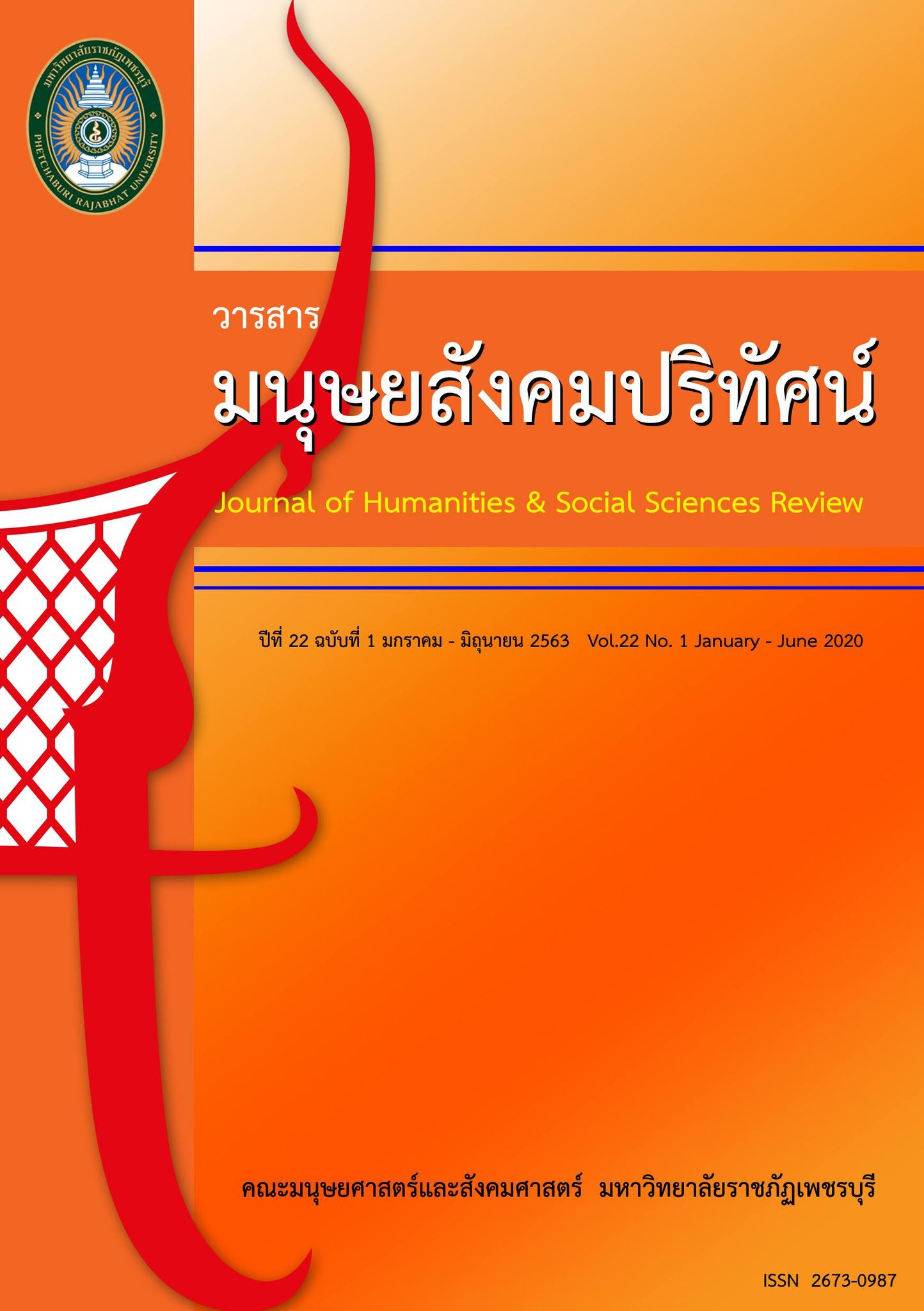The Knowledge Management of Early Rattanakosin Period-Traditional Thai Art in Wat Thewa Sangkharam to Local History and Culture Learning Management for Social Studies Teacher Students
Main Article Content
Abstract
The purposes of this research aimed to 1) manage the knowledge of Thai art in Early Rattanakosin Period at Wat Thewa Sangkharam, 2) propose guidelines for using knowledge about Thai art in Early Rattanakosin Period at Wat Thewa Sangkharam about local history and culture learning management for social studies teacher students.The author collected the qualitative data using information from interviewing the professional and analyzed the information by content analysis. The results of the research found that: 1) The knowledge management of Thai art in early Rattanakosin period at Wat Thewa Sangkharam showed that this temple was built in early Rattanakosin period by written sources from King Nangklao of Siam. It was more obvious at King Chulalongkorn of Siam by the evidence of showing the art sources. Almost art in the temple was the forms and details that identified the influence of the art from Bangkok between King Mongkut to King Chulalongkorn of Siam period. 2) The guidelines using knowledge about Thai art in early Rattanakosin period at Wat Thewa Sangkharam about history and local culture learning management for social studies teacher students had 3 approaches: 1) activity learning management that supported the knowledge of history and culture to be creative work or new knowledge of the learning area of social studies and social studies learning management, 2) learning activity that conformed to students and local in history and culture dimension, so that students knew the value and the importance of the local area, and 3) using the knowledge of history and cultural heritage in the local area to enhance learning activity with other subjects relevant or art and culture conversation project.
Article Details
1. Any views and comments in the article are the authors’ views. The editorial board has not to agree with those views and it is not considered as the editorial board’s responsibility. In case, there is any lawsuit about copyright infringement, it is considered as the authors’ sole responsibility.
2. The article copyright belonging to Faculty of Humanities and Social Sciences, Phetchaburi Rajabhat University are copyrighted legally. Republication must be received direct permission from the authors and Phetchaburi Rajabhat University in written form.
References
กรมศิลปากร, สำนักศิลปากรที่ 3 พระนครศรีอยุธยา, กลุ่มอนุรักษ์โบราณสถาน. (2551). โครงการจัดทำ องค์ความรู้ด้านการสำรวจสถาปัตยกรรมเพื่อการอนุรักษ์โบราณสถาน: อาคารประเภทเครื่องมุงปีงบประมาณ 2551. พระนครศรีอธุยธา: ผู้แต่ง.
เฉลิม มลิลา. (2522). หลักการและวิธีการสอนประวัติศาสตร์ในโรงเรียนมัธยม. กรุงเทพฯ: ภาควิชาหลักสูตรและการสอน คณะศึกษาศาสตร์ มหาวิทยาลัยรามคำแหง.
ตรี อมาตยกุล. (2511). นำเที่ยวจังหวัดกาญจนบุรี ใน พุทธสาสนคติ และรวมเรื่องเมืองกาญจน์. พิมพ์เป็นอนุสรณ์ในงานพระราชทานเพลิงศพ พระเทพมงคลรังสี (ดี พุทธโชติ) เจ้าอาวาสวัดเทวสังฆาราม และเจ้าคณะจังหวัดกาญจนบุรี ณ เมรุวัดเทวสังฆาราม กาญจนบุรี วันที่ 7 เมษายน 2511. ม.ป.ท.: ม.ป.พ.
ทิศนา แขมมณี. (2550). ศาสตร์การสอน องค์ความรู้เพื่อการจัดกระบวนการเรียนรู้ที่มีประสิทธิภาพ. กรุงเทพฯ: สำนักพิมพ์แห่งจุฬาลงกรณ์มหาวิทยาลัย.
มหาวิทยาลัยราชภัฏกาญจนบุรี. คณะครุศาสตร์. สาขาวิชาสังคมศึกษา. (2562). หลักสูตรครุศาสตรบัณฑิตสาขาวิชาสังคมศึกษา (4 ปี) (หลักสูตรปรับปรุง พ.ศ. 2562). (เอกสารอัดสำเนา).
มหาวิทยาลัยราชภัฏวไลยอลงกรณ์ ในพระบรมราชูปภัมภ์. (2557). คู่มือการจัดระบบการเรียนการสอนที่ยึดผู้เรียนเป็นศูนย์กลางการเรียนรู้. พระนครศรีอยุธยา: เทียนวัฒนา พริ้นท์ติ้ง.
เมธินี วงศ์วานิช รัมภกาภรณ์. (2558). แนวคิดจิตตปัญญาศึกษาสู่การปฏิบัติ. กรุงเทพฯ: คณะศึกษาศาสตร์ มหาวิทยาลัยเกษตรศาสตร์.
ยิ่งยง เรืองทอง. (2542). พื้นฐานวัฒนธรรม. อุบลราชธานี: ภาควิชาสังคมวิทยา คณะมนุษยศาสตร์และสังคมศาสตร์ สถาบันราชภัฏอุบลราชธานี.
วรรณกร ทวีแก้ว. (2553). การพัฒนารูปแบบการจัดการความรู้ สำหรับนักเรียนระดับชั้นมัธยมศึกษาในสถานศึกษา สังกัดสำนักงานคณะกรรมการการศึกษาขั้นพื้นฐาน. วิทยานิพนธ์ปริญญาครุศาสตรดุษฎีบัณฑิต สาขาการบริหารการศึกษา บัณฑิตวิทยาลัย จุฬาลงกรณ์มหาวิทยาลัย.
วลัยลักษณ์ ทรงศิริ. (2557). ปฏิบัติการประวัติศาสตร์ท้องถิ่น. กรุงเทพฯ: มูลนิธิเล็ก-ประไพวิริยะพันธุ์.
วัชรา เล่าเรียนดี. (2556). รูปแบบและกลยุทธ์การจัดการเรียนรู้ เพื่อพัฒนาทักษะการคิด. นครปฐม: คณะศึกษาศาสตร์ มหาวิทยาลัยศิลปากร.
ศศิพัชร จำปา. (2558). การพัฒนารูปแบบการจัดการเรียนรู้ประวัติศาสตร์ท้องถิ่นโดยใช้แหล่งเรียนรู้ทางประวัติศาสตร์เพื่อส่งเสริมกระบวนการคิดทางประวัติศาสตร์. วิทยานิพนธ์ปริญญาดุษฎีบัณฑิต สาขาหลักสูตรและการสอน คณะศึกษาศาสตร์ บัณฑิตวิทยาลัย มหาวิทยาลัยศิลปากร.
ศักดิ์ชัย สายสิงห์. (2556). พุทธศิลป์สมัยรัตนโกสินทร์ พัฒนาการของงานช่าง และแนวคิดที่ปรับเปลี่ยน. กรุงเทพฯ: เมืองโบราณ.
สิริวรรณ ศรีพหล. (2553). การจัดการเรียนการสอนวิชาประวัติศาสตร์ในสถานศึกษา. นนทบุรี: สำนักพิมพ์มหาวิทยาลัยสุโขทัยธรรมาธิราช.
สำนักงานคณะกรรมการพัฒนาระบบราชการ (ก.พ.ร.) และสถาบันเพิ่มผลผลิตแห่งชาติ. (2548). การจัดการความรู้จากทฤษฎีสู่การปฏิบัติ. กรุงเทพฯ: ผู้แต่ง.
สำนักงานเลขาธิการสภาการศึกษา. (2560). แผนการศึกษาแห่งชาติ พ.ศ. 2560–2579.กรุงเทพฯ: ผู้แต่ง.
อุไรวรรณ แย้มแสงสังข์. (2555). การจัดการองค์ความรู้เบื้องต้น. กรุงเทพฯ: ไอกุ๊ป เพรส.
Bloom, B., Engelhart, M., Furst, E., Hill, W., & Krathwohl. D. (1956). Taxonomy of educational objectives: The classification of educational goals. Handbook I: Cognitive domain. New York: Long Man Green.
Devries, R., & Zan, B. (1992, Spring). Study compares teachers and classroom atmospheres. The constructivist, 12(2): 1-2, 3-6.
Hills, P.J. A . (1982). Dictionary of education. London: Routledge & Kegan Payi.
Jonassen, D. H. (1992). Evaluating constructivist learning: Constructivism and the technology of instruction. New Jersey: Lawrence Erlbaum Associates Publishers.
McNurlin, B.C., & Spargue, R.H. (2006). Information systems management in practice (7th ed.). New Jersey: Pearson Education International.
Moran, P. (2001). Language-and-culture In teaching culture: Perspectives in practice. Boston, MA: Heinle &. Heinle.
Villegas, A. M., & Lucas, T. (2002). Educating culturally responsive teachers: A coherent approach. Albany, NY: SUNY Press.


